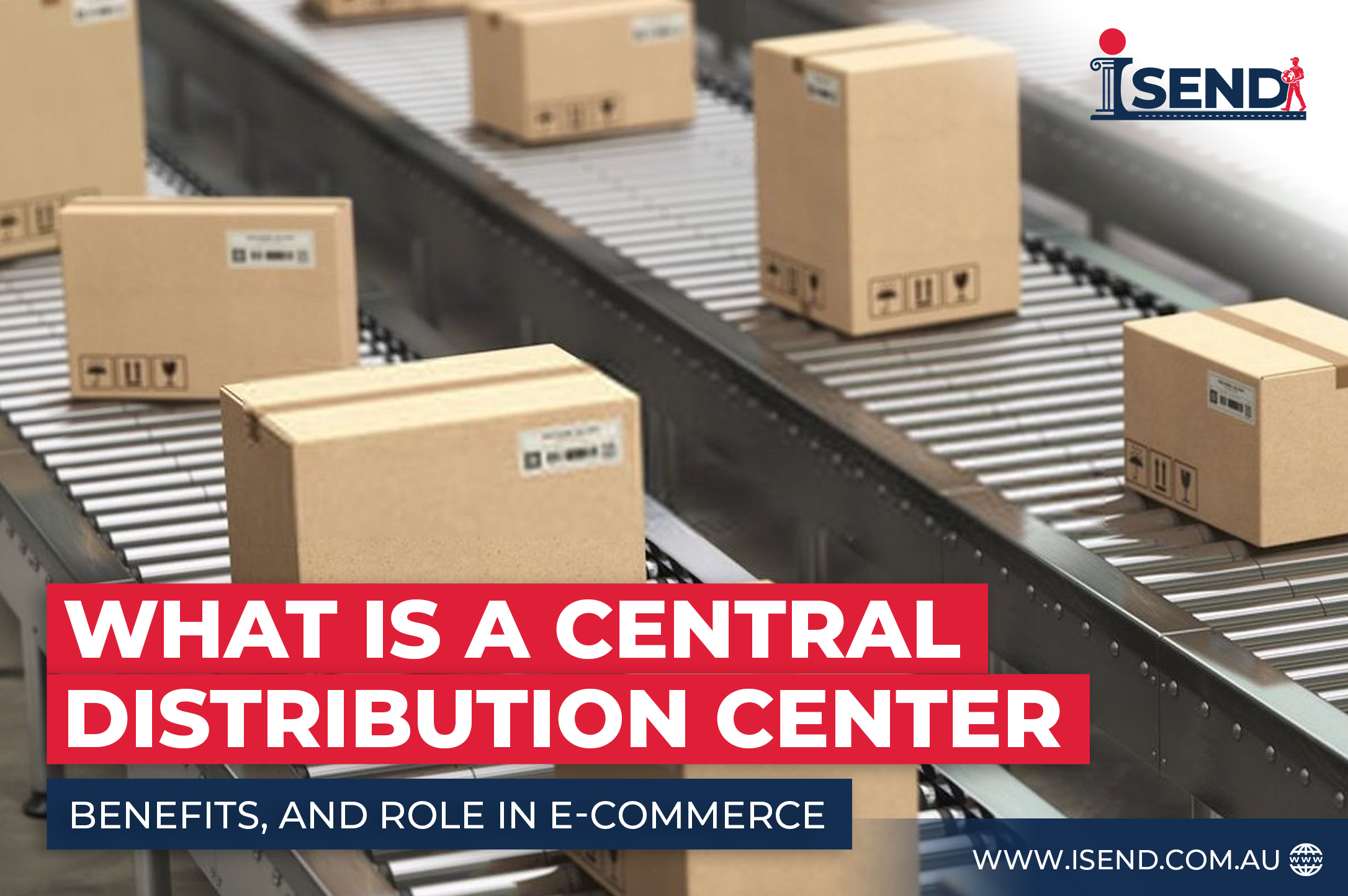A central distribution centre is the heart of the global supply chain. It is a specialised set-up where consignments are collected, warehoused, segregated, and marketed to customers or sales networks. A central hub with good efficiency is paramount to speed, accuracy, and cost efficiency in e-commerce logistics today.
Businesses cannot deliver products on time because they lack well-organised distribution centres. Here is a quick look into the central distribution centre, its role, its advantages, how it facilitates e-commerce fulfilment.
Why a Centralized Distribution Center Is Critical
The advantage of using a central distribution centre is that companies see a streamlining of operations since they can centralise their stock levels into a single central location. Rather than storing goods in different warehouses, they are held in a single storehouse, and access is made as requested. It decreases duplication, enhances storage cost, and improves inventory handling.
In E-Commerce logistical systems, centralisation is vital since online customers demand fast delivery services. Using a centralized distribution centre at an optimal distribution site also saves delivery time and creates uniformity in service. Retailers also use the model to cope with seasonal demand and the unpredictable occurrence of high order volumes.
Core Functions of a Central Distribution Centre
A central distribution centre performs several interconnected functions that keep the supply chain running smoothly.
Receiving
The first step is receiving goods from manufacturers, suppliers, or importers. This is done through unloading goods, checking their accuracy, and updating the stock records. Proper receiving ensures that the inventories of goods are at the right level and ready to be stored.
Storage and Inventory Management
Receiving goods is followed by their storage in organised parts of the facility. The new warehouse and distribution systems have a highly advanced inventory management system to manage stock in real time. This enables businesses to avoid overstocking and stockouts and make data-based decisions. Regular stocktake processes are key here.
Order Preparation (Picking & Packing)
Once the customer has placed an order, it is assembled by picking it up and packing it in the distribution centre. Workers or automated systems track the item, scan it, and pack it to deliver. In order fulfillment, accuracy is key to customer satisfaction; a simple error can slow delivery.
Shipping & Last-Mile Coordination
After the orders have been packed, shipping is the next step. The central distribution centre organises fast and cost-effective delivery with carriers. The final step to the customer, known as last-mile delivery, is especially pertinent to online retailing. A well-organised centre means the dispatching process will be well organised, eliminating delays and shipping costs.
What are the Benefits of a Central Distribution Centre
A central distribution centre possesses several benefits:
Cost Savings
The number of facilities running can cause a company to spend more on rent, labour, and utilities, but consolidation can offer significant savings.
Faster Deliveries
E-commerce logistics provide high-speed delivery due to the increasing centralisation of shipments & enables high-speed delivery lead time improvements.
Better Inventory Control
Companies can maintain inventory in real time, which allows efficiency.
Improved Customer Experience
Orders will take less time to deliver, ensuring increased customer satisfaction.
Flexibility for Growth
With a centralized distribution centre, the business can be expanded to meet increasing demand.
Distribution Centre vs Warehouse: What’s the Difference?
The terms distribution centre and warehouse are mostly confused as synonyms. However, these have distinct differences.
A warehouse is mainly used to store goods over an extended period. It specialises in storage.
A central distribution centre does not just store things, but it also processes orders, packs them, and delivers them. Its concern is the fast transfer of goods.
In brief, distribution centres are warehouses, but warehouses are not distribution centres. In the era of e-commerce fulfilment, distribution centres are becoming more dynamic than storage spaces.
Types of Distribution Facilities
Different companies use different distribution facilities, depending on their size, market, and delivery requirements. There are various types, each with a distinct role in contributing to the fast and efficient transport of goods around the supply chain.
Centralised Distribution Centre
A significant regional hub with a single inventory stored and handled at one prominent location. This eliminates redundancy, decreases operating expenses, and provides consistency in performance throughout the supply chain.
Regional Distribution Centres
These smaller hubs are located strategically close to customers. They minimise shipping time, decrease transportation costs, and ensure that E-Commerce logistics can make same-day deliveries or even deliver the next day.
Retail Distribution Centres
These centres assist physical stores through effective restocking. They help keep products on shelves and eliminate overstocking. Also, these enable retailers to anticipate seasonal demand more accurately.
Fulfilment Centres
Dedicated to fulfilling orders via E-Commerce channels, these centres are optimised to pick, pack, and ship orders as fast as possible. They focus more on speed and precision to address the growing online customer demand for speed of delivery.
Cross-Docking Facilities
Such facilities reduce storage because deliveries are transferred to outbound vehicles immediately after they are offloaded. This saves on handling expenses, promotes faster delivery, and can be used to handle perishable or quick-moving products.
Role of Technology in Warehouse and Distribution
The use of technology in contemporary warehouses and distribution centres is enormous.
The major innovations are:
- Warehouse Management Systems (WMS) for real-time inventory tracking
- Robotics and automation to pack and ship orders more quickly
- RFID and Barcode Scanning to eliminate errors
- Use of AI and Data analytics to predict demand and optimise inventory management. AI and Data Analytics to improve demand forecasting
- Cloud-based Systems that unite suppliers, carriers, and retailers in one system
The technologies innovate distribution centres, becoming more efficient and active based on E-Commerce logistics demands.
Strategic Location and the Importance of a Distribution Place
One of the most significant factors determining efficiency is the location of a distribution centre. The proper geographical position of a distribution facility will make deliveries faster, lower transportation costs, and greater coverage of major markets. For example, an online retailer would place a central location on highways, near airports, or ports, so the time to fulfil orders would be shortened.
Companies also use information analytics to determine where to locate their central distribution centres, depending on population density, transport network, and delivery timing.
Challenges in Managing a Centralised Distribution Center
A central distribution centre is effective and saves costs, but it involves risks that should be addressed cautiously. The challenges include financial investment, workforce issues, and overall supply chain performance.
High Initial Costs
Setting up a central distribution centre requires a lot of capital, including land, infrastructure, technology, and staff. High initial costs are an obstacle to small and medium-sized companies.
Risk Concentration
Relying on one distribution center concentrates all risks at a single location. Any natural disasters, strikes, or equipment failure can delay shipments and affect the supply chain.
Complexity of Operations
Managing inventory, order fulfilment, shipping, and returns from one location would be complex. Without automation and digital tools, this complexity causes inefficiency and operational bottlenecks.
Labor Management
The success of recruiting, training, and retention of skilled staff is critical. The treatment of high turnover, deficiency of skills, or even labour shortage can interfere with operations and diminish the general efficiencies of a distribution centre.
.
Best Practices for Efficient Distribution Centres
Invest in Automation
Automation of conveyors, robots, and smart systems can increase the speed and accuracy of orders and reduce human errors. With e-commerce logistics, automation can scale up operations further.
Use Data for Forecasting
Data-driven demand forecasting eliminates oversupply and understock. It facilitates companies’ to hold the appropriate inventory level, reduce expenses, and ensure quick customers’ order fulfillments.
Implement Quality Checks
Conducting quality checks at different stages like receiving, storage, picking, and packing ensures accuracy. Strong quality control measures reduces errors, minimises returns, and strengthens trust in e-Commerce fulfilment operations.
Optimize Layout
A well-coordinated distribution outlay minimises unwanted movement. Locating fast-moving goods close to packing stations saves time. Also, the order preparation process is simplified, improving picking efficiency.
Focus on Sustainability
Engaging in energy-efficient devices, environmentally friendly packaging, and reducing waste improves sustainability. Also, it helps save cost and creates an authentic brand image in a competitive market landscape.
Real-World Examples in E-Commerce Fulfilment
Distribution centres are significant to large retailers, who rely on them to deliver quickly. For example, worldwide E-Commerce businesses use centralised fulfilment centres to handle millions of daily orders. These central distribution centers have innovative and automated robotics, AI-driven systems, and real-time tracking tools.
Smaller companies also have access to shared central distribution centres, where the shippers manage operations on their behalf. This model enables even small dealers to achieve customer satisfaction through fast and constant delivery. Smaller businesses can also scale by partnering with 3PL providers like iSend to gain access to advanced warehousing, inventory tracking, and last-mile delivery.
Conclusion
A central distribution centre is not only a warehouse; it is the core of supply chain processes and instrumental to E-Commerce fulfilment. All products are received and orders are shipped through the same distribution center. Centralising operations under one roof enables businesses save money, increase speed, and provide better customer experiences.
However, running a central distribution centre requires careful planning, smart location choices, and utilising modern technologies. Companies that adapt to these best practices strengthen their goodwill in the competitive world of E-Commerce logistics.








